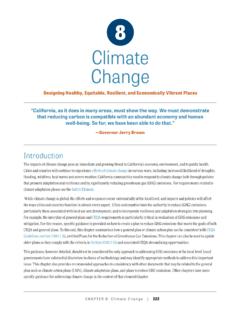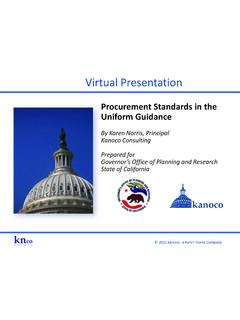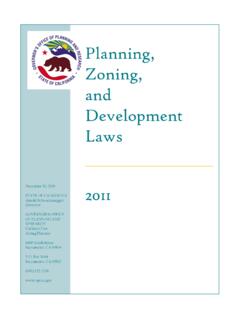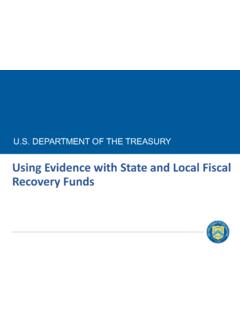Transcription of Mitigated Negative Declarations - California
1 Arnold Schwarzenegger, Governor Mitigated Negative Declarations CEQA Technical Advice Series Governor s Office of Planning and Research 1400 Tenth Street Sacramento, CA 95814 (916) 445-0613 Jan Boel, Acting Director, Office of Planning and Research Terry Roberts, Director, State Clearinghouse December 2004 Edition The CEQA Technical Advice Series is intended to offer CEQA practitioners, particularly at the local level, concise information about some aspects of the California Environmental Quality Act. This series of publications is part of OPR s public education and training program for planners, developers and others. As with all OPR publications, you are free to photocopy this publication in whole or in part. You need not secure written permission; simply cite OPR on any copied information.
2 Acknowledgements OPR sincerely thanks the following people who contributed to prior editions of the publication or who provided materials for inclusion in the appendix. We appreciate their assistance. Curtis Alling, Dames and Moore DeAnn Baker, California State Association of Counties Ron Bass, Jones and Stokes Associates Suzan Brewer, Marin County Community Development Department Ann R. Danforth, McCutchen, Doyle, Brown, and Erersen Al Herson, Jones and Stokes Associates Wendy Morrow, City of Stockton Gary Patton, Santa Cruz County Board of Supervisors John Patton, Santa Barbara County Resource Management Department Pat White, Kern County Department of Planning Michael H. Zischke, Landels, Ripley and Diamond Contributing Staff: Shauna Stringham, OPR Planning Intern The 2004 edition contains updates to the 1997 edition including legislative changes and court opinions. Table of Contents I.
3 1 A. Background of 1 B. Organization of this 1 II. Determining Which CEQA Document to 2 A. What is a Negative declaration ?.. 2 B. The Initial 2 Flow Chart: Generalized CEQA Process ..4 C. Fair Argument D. Required Contents-Project Mitigation and E. F. Public Review and G. Substituting Mitigation H. Mitigation Monitoring or Reporting III. Use With Other A. Master 8 B. Program C. 9 D. Subsequent Negative IV. Court Cases Regarding A. MND B. MND V. Final Appendix A: Selected Excerpts from the Public Resources Code and CEQA Appendix B: Examples of Project Mitigation or Revision Appendix C: Court Cases I. Introduction A. Background of CEQA The California Environmental Quality Act (CEQA) encourages protection of all aspects of the physical environment through disclosure of potential environmental impacts and appropriate action with regard to those impacts.
4 CEQA has changed the course of development and decision making in the public and private sector in California . There are several objectives of CEQA centering on public participation, reduction in environmental damage, interagency coordination and exploration of feasible alternatives and mitigation measures. For many years, lead agencies have adopted Mitigated Negative Declarations (MND) that are designed to mitigate or avoid a project s potential significant impacts. CEQA encouraged the use of MNDs but the process was never specifically part of the law until 1993; two bills, Senate Bill 919 (Stats. 1993, Ch. 1131) and Assembly Bill 1888 (Stats. 1993, Ch. 1130) were passed that outlined the requirements for the adoption of a MND under the appropriate circumstances. Mitigated Negative Declarations discusses the process of adopting a MND in accordance with these two important statutes and the court decisions interpreting the law.
5 This advisory publication is aimed primarily at local public agencies and CEQA practitioners. It is intended to offer basic guidance in the preparation of MNDs and to encourage their use where appropriate. Mitigated Negative Declarations is neither a replacement of nor an amendment to the CEQA Guidelines (Title 14, Ch. 3, 15000 et seq). All code citations refer to the Public Resources code unless noted otherwise. B. Organization of this Advisory This technical advisory explains the statutory basis for using a MND, the circumstances under which the use of a MND is appropriate, the importance of a well documented initial study, the types of project modifications and mitigation measures that may be used to reduce significant effects, and examples of how some lead agencies enforce compliance with mitigation measures. It also discusses how a MND may be used in conjunction with other types of environmental documents, and a brief summary of court cases that specifically address the proper use of MNDs.
6 Appendix A contains the full text of code sections relating to MNDs. Appendix B includes examples of MND agreements which suggest acceptable format for the disclosure of mitigation measures between the project proponent and the Lead Agency. Appendix C summarizes additional court cases that are not directly related to MNDs but are cited in this publication as cases because they set precedence to steps in the MND process. 1 II. Determining Which CEQA Document to Prepare A. What is a Negative declaration ? When faced with a discretionary project which is not exempt from (CEQA), a Lead Agency must prepare an initial study to determine whether the project may have a significant adverse effect on the environment. If such an effect may occur, the Lead Agency must prepare an Environmental Impact Report (EIR). If there are no adverse effects, or if the potential effect can be reduced to a level that is less than significant through project revisions, a Negative declaration or MND can be adopted ( 21080).
7 A MND is a type of Negative declaration that allows the Lead Agency to revise the project prior to circulating the environmental document for public review. The statute provides that MNDs may be used, when the initial study has identified potentially significant effects on the environment, but (1) revisions in the project plans or proposals made by, or agreed to by, the applicant before the proposed Negative declaration and initial study are released for public review would avoid the effects or mitigate the effects to a point where clearly no significant effect on the environment would occur, and (2) there is no substantial evidence in light of the whole record before the public agency that the project, as revised, may have a significant effect on the environment ( ). The prerequisites for adopting a MND include: 1. Making a good faith effort to determine whether there is substantial evidence that the project would result in any significant environmental effect.
8 2. Incorporating effective revisions or mitigation measures into the project to alleviate potential significant effects prior to circulating the draft Negative declaration for public review. 3. evidence in the record to support the agency's determination that there will be no significant effect as a result of the project. B. The Initial Study An initial study formalizes the Lead Agency s preliminary analysis to determine whether an EIR or Negative declaration must be prepared. Most commonly, the initial study is based upon a checklist which illuminates the various environmental impacts which may result from project completion. The checklist, however, is only one part of the initial study. The initial study must also give support for the checklist findings and note or reference the source or content of the data relied upon in its preparation. Simply filling out an initial study checklist without citing supporting information is insufficient to show the absence of significant effects (Sundstrom v.)
9 County of Mendocino (1988) 202 Cal. App. 3d. 296). At the same time, the initial study is not intended to provide the thorough analysis expected of a complete EIR. (Leonoff v. Monterey County Board of Supervisors (1990) 222 Cal. App. 3d. 1337 and San Joaquin Raptor/ Wildlife Rescue Center v. County of Stanislaus (1996) 42 Cal. App. 4th 608). Supporting information may include specific studies which examine the potential significance of an anticipated environmental effect. It may include references to previous environmental documents or other information sources. In any case, a thorough, referenced 2 initial study is a crucial part of the record supporting the Lead Agency's determination to prepare a MND. CEQA requires that the Lead Agency, through its initial study, evaluate the whole of a project. A project must not be broken into smaller parts, each of which alone might qualify for a Negative declaration , in an attempt to avoid preparing an EIR (Association for Sensible Development of Bishop Area v.
10 County of Inyo (1985) 172 151). The decision to prepare a Negative declaration or a MND must be grounded in an objective, good faith effort on the part of the Lead Agency to review the project's potential for significant impacts (Sundstrom v. County of Mendocino, supra). The initial study must be attached to the Negative declaration circulated for public review according to 15071 of the CEQA Guidelines. The purpose of this is to document the reasons supporting the finding that the project will not result in a significant effect on the environment. OPR recommends that prior to circulating a draft MND the Lead Agency revise or annotate the initial study, if necessary, to reflect revisions to the project. The initial study circulated with a MND should not indicate that there will be any significant effects from the project and should identify or reference the data which supports its determination that any potentially significant effects have been Mitigated or avoided.













